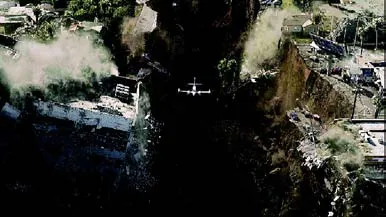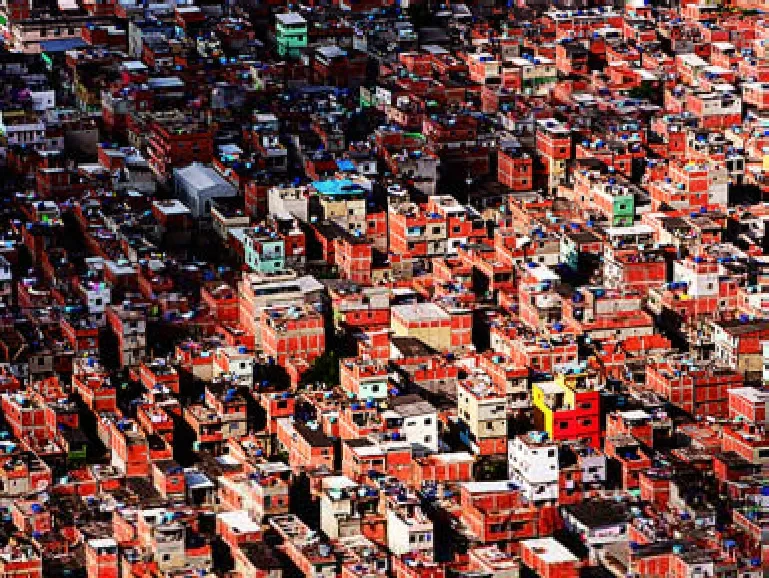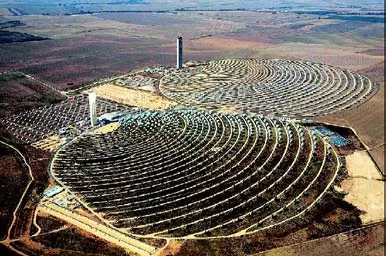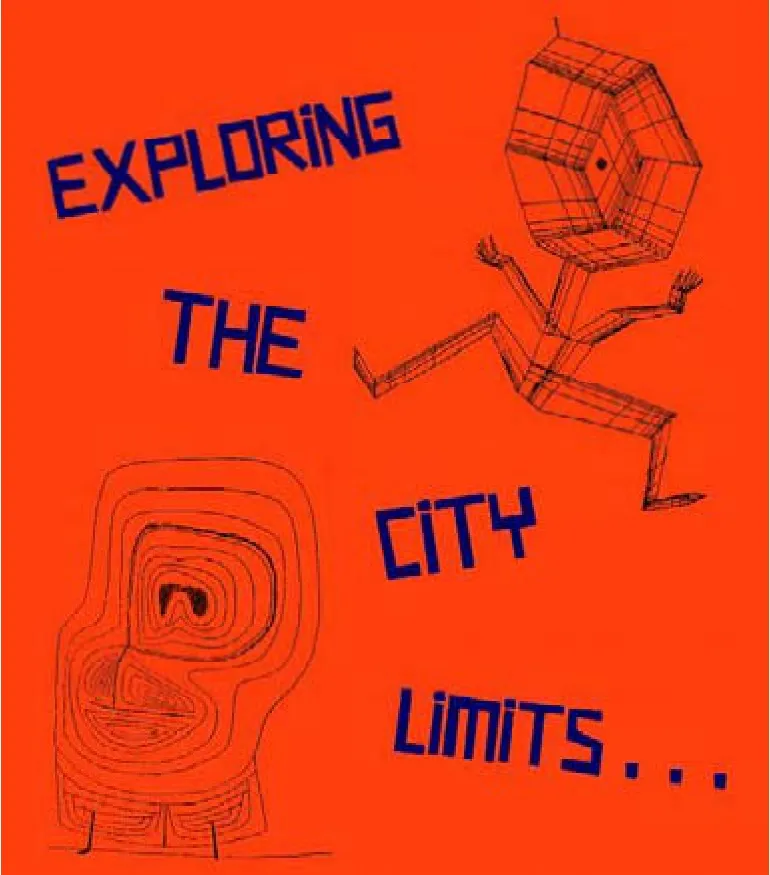最小城市?最大城市?
2010-07-30阿拉斯泰尔唐纳德张烨
阿拉斯泰尔·唐纳德,张烨
引言
未来的城市将何去何从?城市是持续加速扩张,还是衰落、被遗弃以至灭亡?城市将是文化创新与繁荣的中心,还是将因污染拥挤而个性全无?城市将是社会性的,还是反社会性的?
诚然,百家争鸣各持己见。然而,在某种意义上,今天在经济危机之后,西方世界关于未来城市的讨论却几乎被焦虑所主导。关注的焦点集中在城市空间的衰落、社区的瓦解以及城市的萎缩,更有许多学者对发展中国家大城市的飞速膨胀深感忧虑,并担心未来的世界将最终被城市所吞噬。
笔者于2009年末在剑桥大学召集了以“最小或最大城市”为主题的研讨会,试图对围绕城市未来发展的焦虑看法进行探讨。评论家们一方面将经济危机作为城市蔓延的终结而大加褒奖;另一方面又在质问增长和发展的可能性,会议的目的皆在挑战这一影响着西方城市界的局限观念。西方诸多的建筑师已然不自觉地接纳了对人类活动如交通和能源使用的诸多限制,我们试图鼓励与会者们反思对环境和经济发展限制的教条化的认可。毕竟,回顾历史,人类的发展极大地得益于突破环境的限制以及以城市化为代表的人类实践活动的扩展。
忧患未来
在今天的诸多西方国家,与经济复苏共存的是一种普遍的对于未来城市与社会的强烈不确定和深刻不安。新近的灾难电影表现尤为明显:罗兰· 埃默里奇(Roland Emmerich)的《2012》围绕着饱受火山、地震、海啸等空前灾难威胁的人类生存的地球展开;《艾利之书》则以好莱坞视角展示了一个灾难过后满目疮痍的荒芜世界;更有《末日危途》中的那对在文明大毁灭之后的暗无天日的世界中,挣扎于人类自我残杀边缘的父子[1]。
对于未来的悲观情绪同样反映在以生态危机、技术灾难和社会衰败为主导的城市讨论中。如著名城市评论家迪耶·萨迪奇(Deyan Sudjic)所宣称,城市已处于“混乱的边缘”[2],并将随时激起我们内心深处“隐藏的焦躁”(Lurking Paranoia)。美国历史频道“2016未来城市”设计竞赛的获胜方案更是描绘了一幅正消失在茫茫海水中的曼哈顿岛的场景,直接呼应了罗兰·埃默里奇(Roland Emmerich)之前导演的影片《后天》的画面。城市理论家麦克· 戴维斯(Mike Davis)在其著作《恐惧的生态学》(Ecology of Fear)中则将南加州(洛杉矶)视作一个充满现实和想像灾难的场所[3]。里克·克利佛((Rick Kleffel)在对此书的书评中更是极力推崇戴维斯所描绘的充满恐惧、罪恶和灾难的“想像的失控”(Virtual Mayhem),认为其对于恐怖文学颇有启发。[4]
电影和评论中所表现出的不安恰恰折射出了当前普遍存在于西方社会思想中的一种与以往的恐惧所不同的深刻的脆弱性(Vulnerability)。西方1950年代恐怖影片中的洪水猛兽通常只是社会某一特定层面动荡的产物。例如,袭击年轻夫妇或者单身女性的外星怪物反映出的正是人们对于社会全面性解放的种种不安。然而,今天的灾难电影如《末日危途》所反映的则是一种主导当前西方社会思想的无端的广泛的忧虑,进而更传达出了一种强烈的对自我无能为力的悲哀,以及对社会脆弱无力的无奈认同。著名社会学家乌尔利希·贝克(Ulrich Beck)认为,我们正身处于一个“风险社会”[5](Risk Society),在一个全球化的无疆界的世界,无论从时间和空间的层面,还是社会层面,我们都失去了对风险的判断能力。他强调,在一个混乱而缺乏导向的社会中,“人们关注的不再是进步和发展,而是对风险的防范[6]。”贝克的观点得到了霍默·狄克森(Homer-Dixon)的充分赞同,他认为,我们正处于一个充满“无限的不确定”(Unbounded Uncertainty)的时代,而社会的运转也不再以对风险的管理为基础。如他所言:“我们无法衡量(风险的)可能性是因为我们没有对此进行判断的可靠基础。”[7]
人本失位

1 会议海报:最小…或最大城市/Conference Poster: Minimum... or Maximum Cities?

2 忧患城市:西方世界对于大城市扩张的担忧/Anxious City: western fears over mega city growth

3 电影《后天》海报/Movie Poster: The Day After Tomorrow
在某种意义上,这恰恰折射出当前人性观的衰落。事实上,并非我们无法衡量风险发生的可能性,恰恰相反,科技知识的进步极大地增强了我们对于世界的了解和掌控,进而也使我们能够更好地对其变化做出回应。因此,真正改变的是我们对于人类社会的信心——对于人类推动知识进步并作用、改变世界的能力的失信。我们深陷自我怀疑的泥潭而无法自拔,这正根植于一种普遍的对于人类社会进步的文化否定。
对于人类社会的失信,或许从环境保护论对于传统的人与自然关系的彻底否定中更明显地表现出来。人类实践活动向来以改变自然、推动进步为目的,而今天,自然则变得神圣不可侵,人类更是被完全视作扰乱甚至威胁自然生态系统的负面因素。人口增长所带来的担忧使得“人口定时炸弹”(Human Time Bomber)的概念在西方世界耳熟能详;对于有限资源的顾虑则使得我们漠然于医学进步所带来的人类寿命的延长,却将人口老龄化视为引发未来社会问题的症结所在。或许正如《阿凡达》中揭示出的当今时代的遁世思想:尽管詹姆斯·卡梅隆(James Cameron)因完美的三维动画效果而广受褒奖,电影却将人类的破坏力尽显无遗——一个蹂躏自然的卑劣种族,将自我的苦难转移到另一个星球。于是,人与自然和谐相融的原始社会成为了唯一答案。
对于人类社会的全面失信使得环境保护论被教条化地理解并使用。进而人类的探索行为被简单地视作对自然的“干涉”,而增长、技术革新甚至发展本身更是在可持续发展的信仰下被视作威胁自然界稳定性的根源所在。正如世界著名的工程机构ARUP所宣称——“没有自然的灾害,只有人类活动所引发的自然灾害。”[8]
因此,在西方当前保守的宿命论式的城市讨论中,雄心勃勃地寻求变革的规划方案往往被冷眼相待,而如新城市主义等理论则因其“志向的谦逊”[9](modesty of ambition)而备受推崇。城市研讨的焦点集中在保证生存以及如何形成应对危机的“地方性弹性”(Local Resilience),而非人类的进步和发展。不同于以往城市规划师和设计师期望通过城市化进程扩大社会网络和人类活动的范围,推进全球化进程,整合供应链并形成成熟的国际化的劳动力分配体系,今天的环境保护论者以及生存主义者们恰恰试图缩减、分割甚至脱离这一网络,并极力地鼓励地方化的资源分配以及食品供应模式。这一主张即简单地基于弱化人类对环境影响的观念。正如某位环境保护论者所提倡的“使人类活动趋于无形化”。
可持续性的教条化
在某种意义上,西方当前社会文化的转型正源于对现代性和人类进步观念的批判。环境保护论者教条化地将人类活动视为破坏性的、不计后果的和挥霍无度的,而一切的城市化建设和发展都必须符合苛刻的“环境安全”标准,由此对计划的可持续性进行所谓的验证。与以往将人类的获益作为评价发展的价值标准恰恰相反,在这一悲观的社会文化下,可持续发展的政策教条化地将对自然的保全,而非协调自然和人类的关系,简单地作为先决条件。
以英国为例,这一价值标准使得大量的城市基础建设,如发电站、机场、公路以及铁路等,都被迫纳入了一个似乎无止境的风险评估过程。譬如,核电站的建设在可持续发展的拥护者们关于污染、恐怖袭击、废料处理,以及对于生态多样性的威胁的反对声中依然停于纸端。而能源问题的焦点更是从能源的供给,完全转向了通过法令、制度以及提高价格来减少个人的能源消耗。再者,英国交通设施的发展也十分缓慢,大部分使用中的高速公路均建于半个世纪之前,而新兴的高速铁路计划也因为其对乡村的入侵而被迫搁浅。最后,伦敦泰晤士河上一座简单的公路桥项目更是夭折在近1/4个世纪前的规划中,环境保护论者们抵制交通联系的加强所带来的社会价值,并抗议随之而来环境污染和沉重的交通负担[10]。
悲哀的是,就风险管理而言,可持续性的教条化恰恰鼓励着对于发展中可能出现的最差结果的无端推测,而发展项目的反对者们正好借此放大对环境的负面影响和安全隐患,进而阻止项目的进行[11]。恰如一位研究者所言:“激发忧虑的信息会使得行动格外敏感”[12]。然而,更为严重的是,对可持续发展的教条化理解会导致一种僵化的城市发展观念,因为对风险的放大本身就具有麻痹性的效果——一种自满和自得的情绪会通过那些假想风险并声称采取安全负责的行动的人们而衍生并扩散[13]。令人担忧的是,这种对于理性思考置之不顾而简单升级风险等级的方式,不恰恰是对人类知识的抛弃和对直觉的简单片面地依赖吗?而真正成功的规划与设计却正是以人类坚实的知识为基础的。至此,我们不禁要问,设计师将如何逃离这一堕落的漩涡呢?
重审城市和文明
人类历史上最为经典的城市设计和规划大多产生于弘扬人性,尊重人本,鼓励人类探索世界,理解世界并且改变世界的时代。自文艺复兴的人性解放以来,人被视作宇宙中心和万物之本,宇宙学、天文学以及生物学等领域的重大突破均极大地扩展了人类对于自然的了解,更增强了人类发展未来社会的自信。正如城市理论大师彼得·霍尔(Peter Hall)所言,佛罗伦萨的天才们的本质便是孜孜不倦地实验、进取和改变[14]。佛罗伦萨也由此被广泛地作为文明进步的同义词。

4 电影《2012》海报/Movie Poster: 2012

5 电影《末日危途》海报/Movie Poster: The Road

6 人口定时炸弹:西方世界对于东方人口增长的担忧/Human time bomber: western fears over population growth in the East
然而,哲学家约翰·阿姆斯特朗(John Armstrong)在其著作《寻找文明》中却指出,“文明”(Civilisation)的概念在今天已经变得愈发没落[15]。“文明”一词的语源是拉丁语的“城市“(civilisatio)、”城邦”(Civitas),而“城市”、“城邦”又都是“市民”(Civis)一词的派生。他认为,除了“上帝”这个概念之外,“文明”的概念或许是人类迄今为止最为伟大的创造,其与“贵族”、“理想”、“美观”、“真实”等经典概念联系紧密。建筑与城市设计从来都被作为贵族艺术,而城市空间更是得益于对基于文明理想之上的精神繁荣的追求。
阿姆斯特朗更指出了思考未来城市发展的关键。他认为,文明的进步需要物质与精神两个层面——精神繁荣建立并结合在对物质繁荣追求的基础上。两者相辅相成的案例不胜枚举:文艺复兴时期的佛罗伦萨是欧洲最富有的城市;金融服务业和银行业的改革为奥斯曼的巴黎林荫道和街道生活的出现提供了重要支持;而高层建筑和城市公园更是诞生在作为美国资本主义发展前沿阵地的芝加哥。今天的西方思想恰恰忽视了与文明紧密相连的物质繁荣,将人们的“幸福感”作为关注的焦点。具有讽刺意味的是,这一“诊断性概念”(therapeutic concept)提出的同时,人们却无知并漠视物质繁荣的价值。然而,对于文明的追求远不止是幸福感或者内心满足的状态,阿姆斯特朗提出了一个更加积极的概念“人性繁荣”(Human Flourishing)。那么,我们又应当如何看待这一联系城市和文明的概念呢?
积极的人类实践
“文明”(civilisation)一词在18世纪启蒙运动时期的英法等地被广泛使用。在当时,人类文明即代表着世界的进步,代表着事物发展的方向,由此也反映出了以人本为中心的社会思想形态。在这样的社会中,人类对于改变自然推动发展的信心不断增强。
诚然,在人类历史上,我们不断地调整自我以适应自然,我们学会了在恶劣的环境下生存,甚至适应无论冷热干湿的极端条件。然而在我们知识有限、对于自然资源利用不足的时代,自然环境在更多的情况下成为人类进步的“阻碍”。
社会和城市的“繁荣”(flourishing)正是建立在人类更多地了解自然、掌控自然、利用自然的基础上。譬如,我们修建引水渠和灌溉系统以收集并保存水源,进而有力地推动了城市的发展。随着文明的进步,这些工程的意义更是远远超出了满足当时实际功能需求的价值。作为人类文明工程的璀璨结晶,横亘在法国南部乡村的引水渠以及伊斯坦布尔的地下贮水宫殿,无不映射着人类社会对于如何使自然适应自身需要的强大信心。
在历史上,我们不仅“引导”(Channel)自然,更“改变”[16](transform)自然以推动文明的前进,这尤为突出地体现在芝加哥的城市发展进程中。经济大萧条之后的1933年,以“一个世纪的进步”为主题的芝加哥世博会,不仅是一场欢庆科学进步与工业发展的盛会,更展现了一个不断克服重重自然困难和挑战、推动社会进步的充满乐观主义的城市形象。当建于湿地之上的城市逐渐下沉时,建筑从困境中得以拯救;当密歇根湖的洪水向城市袭来并污染城市供水时,运河的开凿,长达176km的疏水系统的修筑逆转了河水的流向;当城市毁于1871年的大火后,升降电梯技术的出现促使摩天大楼拔地而起。诚然,笔者在此并非要褒扬人类对于自然的征服,也绝非回避或者否认上述进程中的负面效应,或许改变最初的城市选址便可避免其中的许多问题。然而相比较于今天城市探讨中人本的失信,芝加哥城市发展中所体现出的人性“繁荣”无疑对现在是具有启发意义的。香港赤腊角新机场的建设更是一个重构自然而推动发展的成功案例,其已成为全世界最为繁忙的货运港口,并且在珠江三角洲的区域发展中扮演着极为重要的角色。机场建于包括原赤腊角岛、榄洲岛以及部分填海工程所形成的人工岛上,并建设了多条公路以及铁路通道连接九龙、港岛以及新界,其中便包括世界最长的悬索桥——青衣大桥。
在今天西方社会看来,如此雄心勃勃的规划方案不免要被贴上标榜人类傲慢的标签。雷切尔·卡森(Rachel Carson)在其著作《寂静的春天》(Silent Spring)中,开篇便描述了一幅在美国腹地的万物和谐的小镇景象[17]。然而,我们不禁要问,农业和城市的发展不恰恰是人类利用、控制并改造自然的实践活动吗?著名作家阿兰·德波顿(Alain de Botton)曾颇为极端地说到:“自然之道即腐化、融化、软化、锈化,与我们赖以生存的法则背道而驰。”他更在其著作《幸福的建筑》(Architecture of Happiness)中强调“秩序与生命殊途同归”[18]。暂且不论德波顿的极端观点,然而需要承认的是,社会整体有效的应对风险的能力,却并不因为我们对自然的“敬重”或者对于可能出现的灾难后果的“放大”而提高。应对危机的弹性(Resilience)更源自我们从积极的实践活动中积累的经验。在一定意义上,人类实践活动的本质便是对自然的改变,也正是在人类对自然的认识和掌控的不断提高的过程中,社会的价值得以强化,其最基本的形态便表现为人类在城市的聚集。笔者在此绝非与自然为敌,只是一旦我们否认了人类对自然的实践活动,便意味着我们放弃了探索和改造自然所能带给我们的利益。
无疑,未来城市的发展是可能从人类实践的探索中大大受益的。悲观地说,当前针对自然系统开展的大量深入的研究,是对于人为的全球气候变化的反面肯定,然而更为重要的是,这一过程无疑将大大加深我们对于自身发展对气候影响的认识——从工业革命时期快速扩张下的无意识破坏到现在的有意识控制。在此意义下,以核能、氢能、风能、太阳能以及潮汐能为代表的新能源的开发,将不仅仅是对“低碳”的有效贡献,其更以大型的人造工程昭示了包含气候在内的自然世界能够在人类的控制下得到长足的发展。
探索未来
著名城市规划大师埃德蒙·培根(Edmund Bacon)在其著于1960年代末的《城市设计》中首先便将城市作为人类文明的最高抱负的表现。他指出,当我们思考城市时,一个最为关键却往往被忽略的概念便是:未来是我们创造的。通过回顾自雅典以来的城市发展历程,培根展示了设计师如何一次次地发展、检验并提炼思想,进而创造适合人类发展的环境——“城市作为一种意愿行动”。
他借用著名艺术家保罗·克利(Paul Klee)的“内向人”(Ingrown Man)和“外向人”(Outgoing Man)强调了开放的探索的认知途径的价值。主导今天西方社会的似乎正是前者。如培根所述:“内向人顾影自怜,明哲保身,把同外界的接触降到绝对的最低的限度……而外向人则奔放且容易介入各种事情,力量和弱点都暴露在外,明知摔跤却跃向空中,即使易受攻击也受之泰然。”[19]
培根在此所表明的恰恰是一种可能阻碍我们探索并创造美好未来的文化意识——对人类试验并实践新理念,并由此将我们的观念施加于城市之上的信心的丧失。矛盾的是,从“外向人”似乎在鼓励我们去重拾那种走向失败的自信,然而明知失败却依然跃向空中的行动却将一种百折不挠、勤于反思的勇气注入到我们精神思想。□
Introduction
What is the future for cities? Are they expanding at an ever-increasing rate or are they being abandoned and shrinking into oblivion? Are cities dynamic centres of innovation and culture or are they polluted, overcrowded and anonymous? Are they sociable or anti-social?
Well, the answers differ depending on who you read. But throughout the Western world, discussion of the metropolitan future is shot through with confusion and anxiety. Some point to decaying urban spaces and fragmenting communities in western cities, while others fear a culture of urban shrinkage; many fret over the dynamic growth of megacities in the developing world and worry that the future will be one where the city will have finally swallowed the world.
At the University of Cambridge, the conference,Minimum... or Maximum Cities?, was convened to explore emerging attitudes and anxieties over the metropolitan future. Given some commentators celebrated the recent recession as a way to curtail a supposed Age of Excess, and others have questioned whether growth is still possible, the aim of the conference was to challenge the low horizons that infect western discourse. While many western architects now accept that restrictions should be placed on human activities such as travel and energy use, we encouraged our contributors to challenge the idea that designers should accept environmental and economic limits. After all, history suggests that humanity has benefited enormously from freeing itself from environmental limits, and instead expanding human networks through ambitious programmes of urbanisation.
Fearing the Future
In early 2010, even as most western countries emerge from the recession, there remains a powerful sense of disorientation, and a deep sense of unease about the future of society. Perhaps this is most apparent from the recent popular releases in cinemas.2012, the latest sci-fi epic from Roland Emmerich,revolves around a scorched earth that threatens human survival. In The Book of Eli, America, seen through Hollywood eyes is a post-apocalyptic wasteland, while in The Road the survivors of an unnamed catastrophe negotiate mindless violence and cannibalism in a landscape devoid of sunshine and covered in thick grey ash[1].
This fearful outlook on the future is also present in recent thinking on cities where the imagination willingly hovers over the prospect of ecological catastrophe, technological disaster, and social decay.The respected urban commentator Deyan Sudjic, for example, argues cities are on the “edge of chaos”and can bring out our “lurking paranoia”.[2]The winners of the US History Channel competition to design the City of the Future 2106 show the towers of Manhattan Island disappearing under flood waters in a clear reference to Roland Emmerich's earlier filmThe Day After Tomorrow. And for the urban theorist Mike Davis, the Southern California landscape provides a setting for real and imagined disasters[3], prompting one reviewer to recommend the ‘virtual mayhem’ of these “entertaining travelogues in fear, crime and disaster” as useful material for horror writers.[4]
The anxieties captured recently in books and films reveal a deep sense of vulnerability that has a very different character to past fears in western societies.In the horror films of the 1950s, cinematic monsters were often the product of specific aspects of societal unease. For example, the aliens or monsters that attacked young couples or single women reflected the fears of a society anticipating the coming sexual revolution. Today, however, the cinematic apocalypse in films such as The Road reflects a more unfocused and diffuse angst Such works convey a strong sense of powerlessness, of a society that perceives itself as brittle and vulnerable. The sociologist Ulrich Beck for example argues that we now live in a ‘risk society’[5]-a globalised, borderless world which he argues,undermines our ability to assess risk, either spatially,temporally or socially. Given this sense that society has been cut adrift, it's perhaps little wonder that he argues“one is no longer concerned with attaining something‘good’, but with preventing the worst”.[6]Another commentator reinforces this point suggesting we live in an era of‘unbounded uncertainty’and that society no longer operates on the basis of manageable risks:“we can't estimate probabilities because we don't have any clear basis for making such a judgement”.[7]
Loss of confidence in humanity
The idea of‘unbounded uncertainty ’suggests an impoverished view of humanity has become. In reality,it is not that we lack knowledge to estimate probabilities.While we could certainly go much further, in recent times, advances in knowledge and technology that ensure we are more capable than ever before of understanding the world, and therefore of acting upon it. What has actually changed is humanity's own confidence in itselfboth in terms of its capacity to develop knowledge, and to act as a force to intervene and shape the world. We have effectively become paralysed by self-doubt, the root of which is a widespread cultural disenchantment with the progress of human society.
This disenchantment is expressed by the environmentalist outlook in which the enlightenment relationship between humanity and nature has been reversed. Where once mankind saw it as its duty to shape nature to its advantage, today the natural world is treated as sacrosanct, and humanity viewed as a burden that threatens to upset natural processes and eco-systems. Amidst fears over population growth, it has become common in the west to hear about the idea of the‘human time bomb’; and instead of celebrating medical advances that lead to increases in life expectancy, amidst fears over resource use, an aging population has now become the focus of societal fears. Perhaps it is the film Avatar that captures the misanthropic prejudices of our age. While James Cameron's has been praised for its 3D technologically sophistication, its message is that humanity is a destructive force-a vile species that rapes nature,and even exports its misery to other planets. Instead it is the primitive society which is celebrated for its apparent respect for nature.
In the environmentalist worldview, human endeavour is recast as“interference”in nature.Growth, new technologies, and even development itself are now viewed under the doctrine of sustainable development as problematic activities that threaten the stability of the natural world. In the view of the engineers Arup,“there is no such thing as a natural disaster, only human interference in the natural world,which causes problems”.[8]

7 风险城市:专注于风险防范的脆弱社会/Risk city: a vulnerable society that concerns preventing the‘worst’

8 奥斯曼的巴黎改造/The Hassemann Plan, Paris

9 罗马输水渠:人类文明进步的标志/Roman aqueducts: symbol of civilization progress

10 1933年芝加哥世界博览会/Chicago in World Fair 1933

11 香港赤腊角新机场/New Hong Kong airport in Chep Lap Kok

12 太阳能:新技术将帮助人类避免发展对环境的无意识破坏/SolarEnergy: new technologies that help us progress from unintentionally influencing the environment

13 保罗. 克利:内向人和外向人/Paul Klee: Ingrown man & Outgoing man
Consequently, in the newly conservative and fatalistic western urban discourse, plans that argue for ambitious, transformational change are increasingly frowned upon, while the likes of New Urbanist movement is celebrated for its “modesty of ambition”[9].Instead of human progress, there is a sense that survival or creating ‘local resilience’ is all that can be hoped for. Indeed, where once designers sought through urbanisation to expand human networks and increase the human presence across the planet,environmentalists today fantasise about scaling down and disconnecting from large scale human networks.Instead of the maximising ambitions that once celebrated global connections, integrated supply chains, and a sophisticated international division of labour, today's survivalist mentality feeds a desire to opt out-to go‘off grid’, and to confine communities to the use of local materials or locally produced food.Underlying this approach is the desire to shrink human influence on the world, or as one environmentalist puts it, ‘to make humanity invisible’. The bestselling book The World Without Us even anticipates a posthuman future where cities are re-colonised by nature.
The Rise and Rise of the Sustainability Police
Such hostility to modernity and the notion of human progress has served to transform the culture and practice of urbanism in the West. In line with the environmentalist decree that mankind is reckless, destructive and wasteful,all aspects of development and urbanisation are now subject to a relentless series of environmental‘safety’tests that purport to establish whether proposals are‘sustainable’and therefore permissible. In contrast to the past where the starting point for thinking about development was the benefits that could be secured for mankind, for today’s sustainability police it is safeguarding natural systems that are the first and often defining consideration.
In England such thinking undermines the building of infrastructure like power plants, airports, roads and railways which are now subjected to endless consultation and risk assessments processes. For example, a new generation of nuclear power stations remains on the drawing board as sustainability advocates talk up the risks associated with contamination, terrorism, waste disposal and threats to bio-diversity. Indeed much of the energy focus has shifted from growing energy supply to increasing regulations, laws and cost in order to force individuals to cut their consumption. Transport infrastructure has also been undermined with the UK relying on a motorway systems that was largely completed half a century ago, and new high speed train lines are threatened by those hostile to development in the countryside. Even relatively simple projects such as road bridge over the London Thames river can be trapped in planning for a quarter of a century as environmentalists reject the social benefits of greater mobility and protest that emissions and traffic will inevitably increase, as if designers are no longer capable of innovating around such problems.[10]
The sustainability framework of risk management unfortunately serves to encourage speculation on what might be the worst possible outcomes of development as those opposed to a project inflate the potential for adverse environmental and safety impacts as a means of stopping projects going ahead[11]. According to one researcher, “communication which produces high fear can lead to sensible action”[12]. Yet the more important outcome of the sustainability approach is surely an urban imagination that becomes imprisoned-as risk
inflation itself has a paralysing effect, while encourages self-congratulatory feel good factor by those who the claim to be acting safely and responsibly in the face of the supposed threats.[13]Worryingly, an approach based on setting aside rational thinking and instead cranking up the levels of fear is really an invitation to defer to intuition and prejudice rather than to rely on human knowledge-the very attribute that successful design and planning surely rely upon. So how might designers escape from this downward spiral?
Cities and Civilisation
Some of the finest design relates to periods in history when humanity prospered through a heightened confidence in its ability to comprehend the world, and through doing so, acted to improve it. From the Renaissance onwards, as mankind came to understand its place at the centre of the universe, breakthroughs in cosmology, astronomy, and physiology exerted an enormous boost to human confidence that it could shape the future of society. The essence of the Florentine creative genius, for example, was a desire for constant experiment, constant improvement, and constant change.[14]
Florence is a city that is synonymous with the advance of civilisation. However, as the philosopher John Armstrong argues in his book In Search of Civilisation,[15]the concept of civilisation has become distinctly unfashionable in recent times. Armstrong offers some important pointers as to how we might think about the future of the city. The Latin word‘civis’is, he recaps, the root of‘city’. With the possible exception of God he argues, civilisation is the grandest, most ambitious idea that humanity has
devised. His liberal use of old fashioned words such as‘noble’,‘ideals’,‘beauty’, and‘truth’remind us that architecture and urban design were once noble arts, and that urban space benefitted from a commitment to spiritual prosperity embodied in civilised ideals.
Importantly, Armstrong argues there are two sides to the pursuit of civilisation; spiritual prosperity he points out is only possible in combination with the pursuit of material prosperity. There are many examples of how these forces can work together.Renaissance Florence itself was the richest city in Europe; financial services and innovations in the banking system were an important backdrop to the emergence of the boulevards and street life of Haussmann's Paris; and in Chicago, the frontier of American capitalism, grew for its famous skyscrapers and beautiful urban parks. Today, it has become fashionable in western discourse to frown upon material prosperity associated with civilisations and instead to celebrate ‘well-being’and ‘happiness’-two largely therapeutic concepts that have emerged at a time when many are dismissive of the benefits of material prosperity. But a search for civilisation argues Armstrong requires more than ‘happiness’ or a state of inner contentment. He offers a useful alternative as the more ‘active’ notion of human ‘flourishing’.So how can we make use of this connection between cities and civilisation?
Expanding the human footprint
Use of the word‘civilisation’came into widespread use in Britain and France during the enlightenment years of the eighteenth century. One of the key ideas of the day was that human civilisation represented an improvement on the natural world, or the way that things just happened to be. It reflected a time when human society became more confident about its role in transforming nature to its advantage.
For much of human existence, mankind has been forced to adapt itself to nature. Certainly we learnt to survive in many inhospitable environments and could even adjust to fairly extreme circumstances whether hot, cold, wet, and dry. But in times when knowledge was relatively limited, and we lacked the ability to use too many natural resources, nature tended to form a barrier to human progress rather than aid it.
Human society and cities themselves truly started to flourish when humanity gained the ability to take more control of nature and started to organise the natural world to its advantage. For example, our ability to build aqueducts and piping systems to move water away from where it happens to gather and to retain it near where we want to use it has helped cities and their citizens prosper. Sometimes these solutions are merely functional; but as civilisation progressed,often they go way beyond what is needed to practically achieve our aims. The aqueducts that march across the countryside of southern France, or the Basilica Cistern beneath the streets of Istanbul are beautiful engineering solutions devised by human societies that were becoming confident in the knowledge of how to adapt the environment to its own needs.
At other times still, we do much more than adapt nature, we transform nature.[16]This process is writ large in the city of Chicago which in 1933 hosted a World Fair to celebrate the scientific triumphs of the telegraph, telephone, automobile, and airplane. Even in depths of the depression, the Fair reflected the optimism of a city that had modified nature to its advantage and in doing so conquered the forces that continually threatened its existence. Constructed on swampland, when the city started to sink buildings were literally jacked up out of the quagmire; when its topography and position on the Shores of Lake Michigan resulted in flooding and the contamination of water supplies, engineers reversed the flow of the river, built expansive canal systems, and, over time, the 110 mile long Deep Tunnel System water distribution system;after the city was destroyed by the 1871 fire, architects utilised fire proofed steel and new lift technology, to develop the skyscraper, the building typology that stands in determined defiance of gravitational forces.
One excellent example of the human ability to reorganise nature to its advantage comes in the form of the New Hong Kong Airport which has become the busiest international cargo terminal in the world and has played an important role in assisting the recent rapid growth in the Pearl River Delta (PRD) region in South China. To build the airport the mountainous Chep Lap Kok and Lam Chau islands were flattened and then connected to create a whole new useable land mass within the sea that could support the new airport.Many miles of tunnels, bridges and roadways, including Tsingh Ma Bridge, the world’s longest span suspension bridge, were constructed to connect it to the mainland.
In the west today, such ambitious plans for transformation are not only notable by their absence,but very attempt to alter or control nature is now viewed as a symbol of human arrogance. At the start of her famous environmental tractSilent Spring, Rachel Carson claims there was once a town in the heart of America where all life seemed to live in harmony with its surroundings.[17]Yet Carson ignores the fact that agriculture and urbanisation developed precisely as an exercise in imposing human control over the natural world, modifying it in the process. As the writer Alain de Botton remarks‘nature's way is to corrode, melt,soften, stain’, and is ultimately‘opposed to the order that we rely on to survive’.‘The drive towards order’he asserts,‘reveals itself as synonymous with the drive towards life’.[18]In this sense, genuine resilience,and, more importantly, human progress, result from expanding the human footprint. Imposing human infrastructure certainly modifies the operation of nature. But it is this very process of extending human reach and control over the natural world that can bring social benefits including integrating more people into manmade networks. This is not to promote the wilful destruction of the natural world, but to recognise that giving up on the human centred project of mastering nature will leave us at the mercy of circumstances rather than able to benefit from controlling and exploiting the natural world.
However, the future city could also potentially benefit from radically new ways of expanding human influence. The extensive current research on the operation of natural systems does not merely serve to confirm anthropogenic climate change. More importantly, it boosts levels of human knowledge that could help us progress from unintentionally influencing the climate (as we have done in the industrial age),towards consciously controlling our influence. In this sense, geo-engineering and the development of new forms of energy infrastructure (whether nuclear,hydroelectric, solar, wave, wind or coal CCS), can be viewed as far more than just the means of reducing carbon emissions. Rather they represent aspects of macro-engineering advances that could help bring the natural world, including the climate, further within humanity's control.
Conclusion-Exploring the future
Writing in the late 1960’s, the American designer Edmund Bacon affirmed his belief that the city was an expression of the highest aspirations of our civilisation,But, he argued, when thinking about cities, there is a danger we are losing one of the most important concepts of mankind: the future is what we make it.In his survey of cities from Athens onwards, he reviewed how, time and again, designers developed, tested and perfected ideas that led them to humanise their environments, and illustrated that ‘the city was an act of human will’.
To promote an explorative, open ended approach,Bacon highlighted the work of the artist Paul Klee and presented the idea of Ingrown Man and Outgoing Man.It seems to us that today, Ingrown Man is the dominant figure. In Bacon's words, he‘is inward looking, selfconcerned and safe. He reduces contact with the outside world to a minimum avoiding exposure and involvement’. The alternative Bacon presents is Outgoing Man, a figure who is‘ebullient, involved,exposed in both his strengths and his frailties. He reaches for more than he has or knows, he leaps into space, aware of the possible consequences of a fail.’[19]
What Bacon seems to suggest is that the biggest barrier to be negotiated on the way to realising a better future is a cultural one-the collapse in belief that humanity has capacity to experiment with, and then implement new ideas, and through doing so, to impose its vision. Strange as it may seem, the lesson that can be drawn from Outgoing Man is that we need to rediscover the confidence to fail. To leap into space aware of the possibilities of failure signifies confidence that whatever the problems, humanity can emerge on the other side and reflect on the lessons... before trying again.□
注释/Notes:
[1] “2012” http://www.imdb.com/title/tt1190080/“Book of Eli” http://www.imdb.com/title/tt1037705/“The Road” http://pro.imdb.com/title/tt0898367/
[2] SUDJIC D. Cities on the Edge of Chaos[N]. Observer,2008-03-09.
[3] DAVIS M. Ecology of Fear: Los Angeles and the Imagination of Disaster[M]. New York: Vintage, 1999.
[4] KLEFFEL R. Book Review: Mike Davis, Ecology of Fear[EB/OL]. [2010-05-10]. http://trashotron.com/agony/reviews/davis-ecology_of_fear.html.
[5] BECK U. World Risk Society[M]. Cambridge: Polity Press, 1999.
[6] HAMMOND P. Media, War, Post-modernity [M].London: Routledge, 2007.
[7] HOMER-DIXON T. From Risk to Uncertainty[N/OL].Toronto Globe and Mail (2008-03-19) [2010-05-10].http://www.homerdixon.com/download/from_risk_to_uncertainty.pdf.
[8] HEAD P, LAWRENCE G. Urban Development to Combat Climate Change: Dongtan Eco City and Risk Management Strategies [C/OL]// CTBUH 8th World Congress, Grand Hyatt Hotel, Dubai, March 3-5, 2008:Tall & Green: Typology for a Sustainable Urban Future[2010-05-06]. http://www.ctbuh.org/Portals/0/Repository/T6_HeadLawrence.51efe4b5-2805-4e5c-8cfd-92cfcc5bb4b3.pdf.
[9] KUNSTLER J.H. A Reflection on Cities of the Future[EB/OL]. [2010-05-08]. http://www.kunstler.com/mags_cities_of_the_future.html.
[10] VIDAL J, MILMO D. Transport for London Scraps Plans for Six-lane Road Bridge[N]. Guardian, 2008-11-06.
[11] CLARKE L. Possibilistic Thinking: A New Conceptual Tool for Thinking about Extreme Events[J]. Social Research: An International Quarterly of Social Sciences,2008, 75(3):855-872.
[12] ARRANSON E. Fear, Denial, and Sensible Action in the Face of Disaster[J]. Social Research: An International Quarterly of Social Sciences, 2008, 75(3):669-690.
[13] WILLIAMS A. The Enemies of Progress: The Dangers of Sustainability[M]. Exeter: Societas, 2008.
[14] HALL P. Cities in Civilisation[M]. London: Phoenix,1998.
[15] ARMSTRONG J. In Search of Civilisation: Remaking a Tarnished Idea[M]. London: Allen Lane, 2009.
[16] WOUDHUYSEN J, KAPLINSKY J. Energise! A Future for Energy Innovation[M]. London: Beautiful Books,2009.
[17] CARSON R. Silent Spring[M]. London: Penguin,1962.
[18] DE BOTTON A. The Architecture of Happiness[M].London: Penguin Books, 2007.
[19] KLEE P. The Thinking Eye: The Notebooks of Paul Klee[M]// BACON E. Design of Cities[M].Harmondsworth: Penguin, 1967.
